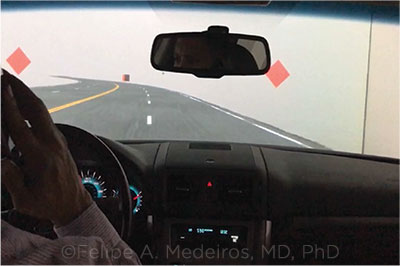Download PDF
Using a mobile phone while driving can be deadly, as this combination is responsible for more than a quarter of car crashes.1 Now researchers at Duke University’s Visual Performance Lab report that the risk is even greater when glaucoma is added to the mix.2
“Patients with glaucoma exhibit a disproportional decrease in driving performance compared to normal subjects when talking on a mobile phone,” said Felipe A. Medeiros, MD, PhD, at Duke University in Durham, North Carolina. “Their reaction times and ability to detect peripheral objects suffered more than those of healthy subjects when driving distracted.”
The study suggests that of two individuals driving 70 mph while talking on the phone, the driver with greater visual field loss will travel an extra 76 feet before responding to a hazard, compared with a driver with a relatively preserved visual field.
 |
CAN WE TALK? In the test, vehicle speed was kept constant at 45 mph, so that the driver only had to operate the steering wheel and respond to phone prompts and visual stimuli.
|
Do you talk and drive? The researchers surveyed 112 patients with glaucoma and 70 healthy controls to determine prevalence of phone use among drivers. Of those with glaucoma, 32 (28.6%) said that they “rarely” or “sometimes” used mobile phones while driving, other than for emergencies. In comparison, 22 of the healthy controls (31.5%) reported that they rarely or sometimes talked on the phone while they drove. What’s more, 38 (34%) of the patients with glaucoma and 36 (51.4%) of controls said that they felt “capable” or “very capable” of driving while talking, indicating that they were unaware of the risks.
Driving simulator. Next, a randomly selected subgroup of 37 patients with glaucoma and 28 controls “drove” with and without a handheld phone at 45 mph on a simulated road. The researchers measured their response time to the appearance of peripheral diamond-shaped targets on the virtual road.
Slower to react. Reaction times to peripheral stimuli were longer in glaucomatous than in healthy patients, both with and without the phone: Without the phone, reaction times were 1.05 seconds in glaucomatous eyes, versus 0.76 seconds in healthy eyes. With the phone, those reaction times increased to 1.86 seconds in patients with glaucoma, versus 1.14 seconds in controls.
And disease severity affected reaction time: Each 5-dB decrease in standard automated perimetry binocular mean sensitivity was associated with an increase of 0.88 seconds in reaction time.
Advising patients. Dr. Medeiros advised doctors to tell patients with glaucoma about their potential increased risk of accidents.
And hands-free options aren’t a good solution, as the evidence suggests there is not much difference between hands-free and handheld phones, Dr. Medeiros said. “That’s because we have an inherent limited ability to divide our attention. In either scenario, you would be driving under distracted attention,” he said. “Having glaucoma further limits our ability to drive safely.”
—Miriam Karmel
___________________________
1 National Safety Council. www.nsc.org/portals/0/documents/distracteddrivingdocuments/attributable-risk-estimate.pdf. Accessed June 17, 2019.
2 Ogata NG et al. JAMA Network Open. 2019;2(4):e192169.
___________________________
Relevant financial disclosures—Dr. Medeiros: NEI: S.
For full disclosures and the disclosure key, see below.
Full Financial Disclosures
Dr. Holland None.
Dr. Kuriyan Alimera Sciences: C; Allergan: C; NEI: S; Regeneron: C; Roche/Genentech: S; Second Sight: S; Valeant: C.
Dr. Medeiros Allergan: C; Biogen: C; Carl Zeiss: C;S; Galimedix: C; Heidelberg Engineering: S; NEI: S; Ngoggle Diagnostics: P; Novartis: C; Reichert: C,S.
Dr. Peeler None.
Disclosure Category
|
Code
|
Description
|
| Consultant/Advisor |
C |
Consultant fee, paid advisory boards, or fees for attending a meeting. |
| Employee |
E |
Employed by a commercial company. |
| Speakers bureau |
L |
Lecture fees or honoraria, travel fees or reimbursements when speaking at the invitation of a commercial company. |
| Equity owner |
O |
Equity ownership/stock options in publicly or privately traded firms, excluding mutual funds. |
| Patents/Royalty |
P |
Patents and/or royalties for intellectual property. |
| Grant support |
S |
Grant support or other financial support to the investigator from all sources, including research support from government agencies (e.g., NIH), foundations, device manufacturers, and/or pharmaceutical companies. |
|
More from this month’s News in Review